Elecnor Deimos presents Europe's most important asteroid and space debris surveillance and tracking centre
Situated in Ciudad Real, the DEIMOS Sky Survey facility positions Spain in the vanguard of space surveillance and trackingIt provides strategic surveillance, tracking and cataloguing services for debris from space missions and asteroids to space agencies and government bodiesIt has three state-of-the-art optical telescopes that capture date and images from space which are processed at Elecnor Deimos' control centre in Puertollano
Madrid, 11 May 2016.- Elecnor Deimos, Elecnor's technological area, today presented its first space surveillance and tracking centre, DEIMOS Sky Survey (DeSS), an advanced complex equipped with the latest technology for observing, tracking and cataloguing space debris and asteroids near to Earth. It is the most important centre of its kind in Europe.
During the presentation ceremony, which included a visit to the DeSS facility on Niefla Mountain in the Valle de Alcudia y Sierra Madrona Nature Reserve in Almodóvar del Campo (Ciudad Real), representatives of the company including CEO Rafael Martín Bustamante and Miguel Belló, General Manager of Elecnor Deimos, welcomed regional and local dignitaries including Emiliano García-Page Sánchez, President of Castilla-La Mancha, and Mayte Fernández, mayor of Puertollano, who had the opportunity to find out first hand about the technology with which this complex is equipped and the strategic services it offers.
The Deimos Sky Survey (DeSS) surveillance and tracking facility has two purposes: to prevent the entry of space objects into the Earth's atmosphere, minimising civil protection risks, and to warn national and international satellite operators of the potential risk of space debris and other objects colliding with their infrastructure (satellites, GPS, etc.), so that they have time to take action and prevent impacts.
To this end, the centre carries out surveillance, collects data and draws up a list of objects that may fall from the sky. Using complex mathematical calculations, it predicts their re-entry orbits and determines almost precisely where an object may fall and whether or not it will disintegrate on re-entry into the atmosphere owing to its dimensions and volume.
The DeSS centre is currently fully operational though it began operating in test mode and to collaborate on some missions for the European Space Agency (ESA) in the second half of 2015. More specifically, last July it tracked the launch phase and initial operations of the MSG4 satellite and at the end of 2015 tracked and captured images of the return to earth of a fragment of space debris known as WT1190F, which eventually landed in the Indian Ocean around 100 kilometres off the coast of Sri Lanka.
The DeSS centre
The centre is comprised of three telescopes that produce neither light, noise, vibrations, radiation nor emissions:
- Centu 1 and Tracker1, for observing objects (asteroids, space debris, etc.) and tracking them at high-altitude orbits: Geostationary Earth Orbit (GEO) objects 36,000 km above the Earth; Medium Earth Orbit (MEO) objects, with orbits above 10,000 km, and Near Earth Orbit (NEO) objects, which can pose a threat in the event of impact.
- The Antsy1 is for the surveillance of Low Earth Orbit (LEO) objects (below an altitude of 2000 km from Earth) and the tracking of Near Earth Orbit (NEOs) objects and Very Fast Moving Objects (VFMOs).
The telescopes are protected from the thermal radiation produced by the heat of the sun by white fibre glass domes.
On clear nights, which are frequent in the area, the telescopes are put into operation and capture images and data from the sky which are transferred by means of an antenna to the control centre at Elecnor's Satellite Integration and Operations Centre in La Nava (Puertollano) for processing. From this centre all the operations of the DeSS facility are monitored, observations are controlled and services are provided to space agencies, satellite operators and government bodies.
Space trackers
Elecnor Deimos, the technology division of the Elecnor Group, leads the way in the development of space systems, ground segment satellites and satellite navigation systems. Since its foundation in 2001, it has played a pivotal role in the ESA's SSA (Space Surveillance Awareness) programmes in three areas: near-earth orbit (NEO) asteroid, climate and space environment and space debris collision risk research.
It plays a leading role in the ESA's Space Weather Segment programme and, in particular, in the Space Environment Information System for Operations SEISOP. It is also involved in other space debris initiatives such as the development of the architecture for the ESA's SST system (SSA CO II), the Space Situational Awareness DC-II Prototype Tasking & Data Center (SSA CDII) project, the web interface for the DISCOS (Database and Information System Characterising Objects in Space) database, the ‘Disposal Strategies Analysis for MEO Orbits’ (MEDEA) project, and the evaluation of methodologies for improving re-entry prediction.


